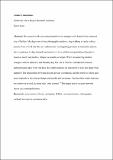Files in this item
Canine connections : fieldwork with a dog as research assistant
Item metadata
| dc.contributor.author | Lane, Karen Lesley | |
| dc.date.accessioned | 2017-12-02T00:32:16Z | |
| dc.date.available | 2017-12-02T00:32:16Z | |
| dc.date.issued | 2015-12-01 | |
| dc.identifier | 251436923 | |
| dc.identifier | 8085ddd3-16dd-4c13-8f2d-a87a2a88dcda | |
| dc.identifier | 84957093099 | |
| dc.identifier.citation | Lane , K L 2015 , ' Canine connections : fieldwork with a dog as research assistant ' , Anthropology in Action , vol. 22 , no. 3 , pp. 27-38 . https://doi.org/10.3167/aia.2015.220304 | en |
| dc.identifier.issn | 0967-201X | |
| dc.identifier.other | ORCID: /0000-0003-3387-6124/work/64361284 | |
| dc.identifier.uri | https://hdl.handle.net/10023/12234 | |
| dc.description.abstract | My research seeks out muted narratives that struggle to be heard in the contested city of Belfast. My dog is one of my ethnographic methods: dog-walking is rarely a direct journey from A to B and she can ‘authenticate’ my lingering presence in unfamiliar places; she is a gateway to dog-focused communal activities; and her categorisation of people is based on smell, not politics, religion or country of origin. When encountering random strangers with an attractive and friendly dog, her role is obvious: introduction enacted, anthropologist takes over. But does she simply mediate the encounter or does she shape what happens? The relationship between dog and person is reciprocal and the extent to which each actor responds to the other prolongs and moulds the encounter. Can she elicit stories that may not otherwise be told, do more than ‘only connect’? This paper draws on actor-network theory and cosmopolitanism. | |
| dc.format.extent | 11 | |
| dc.format.extent | 9341262 | |
| dc.language.iso | eng | |
| dc.relation.ispartof | Anthropology in Action | en |
| dc.subject | Actor - network theory | en |
| dc.subject | Ambiguity | en |
| dc.subject | Belfast | en |
| dc.subject | Cosmopolitanism | en |
| dc.subject | Ethnographic method | en |
| dc.subject | Interspecies communication | en |
| dc.subject | GN Anthropology | en |
| dc.subject.lcc | GN | en |
| dc.title | Canine connections : fieldwork with a dog as research assistant | en |
| dc.type | Journal article | en |
| dc.contributor.institution | University of St Andrews. Social Anthropology | en |
| dc.identifier.doi | https://doi.org/10.3167/aia.2015.220304 | |
| dc.description.status | Peer reviewed | en |
| dc.date.embargoedUntil | 2017-12-01 |
This item appears in the following Collection(s)
Items in the St Andrews Research Repository are protected by copyright, with all rights reserved, unless otherwise indicated.

